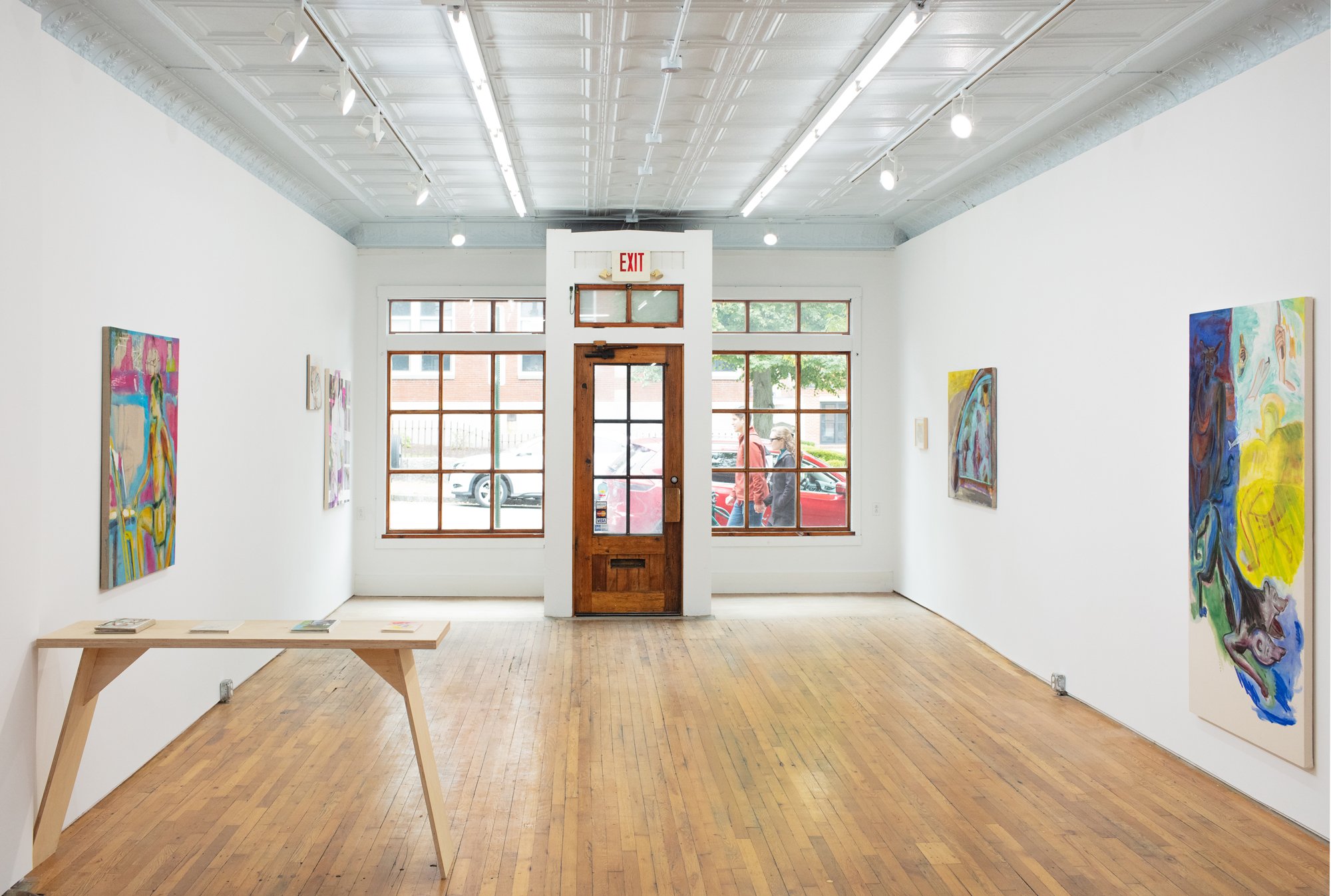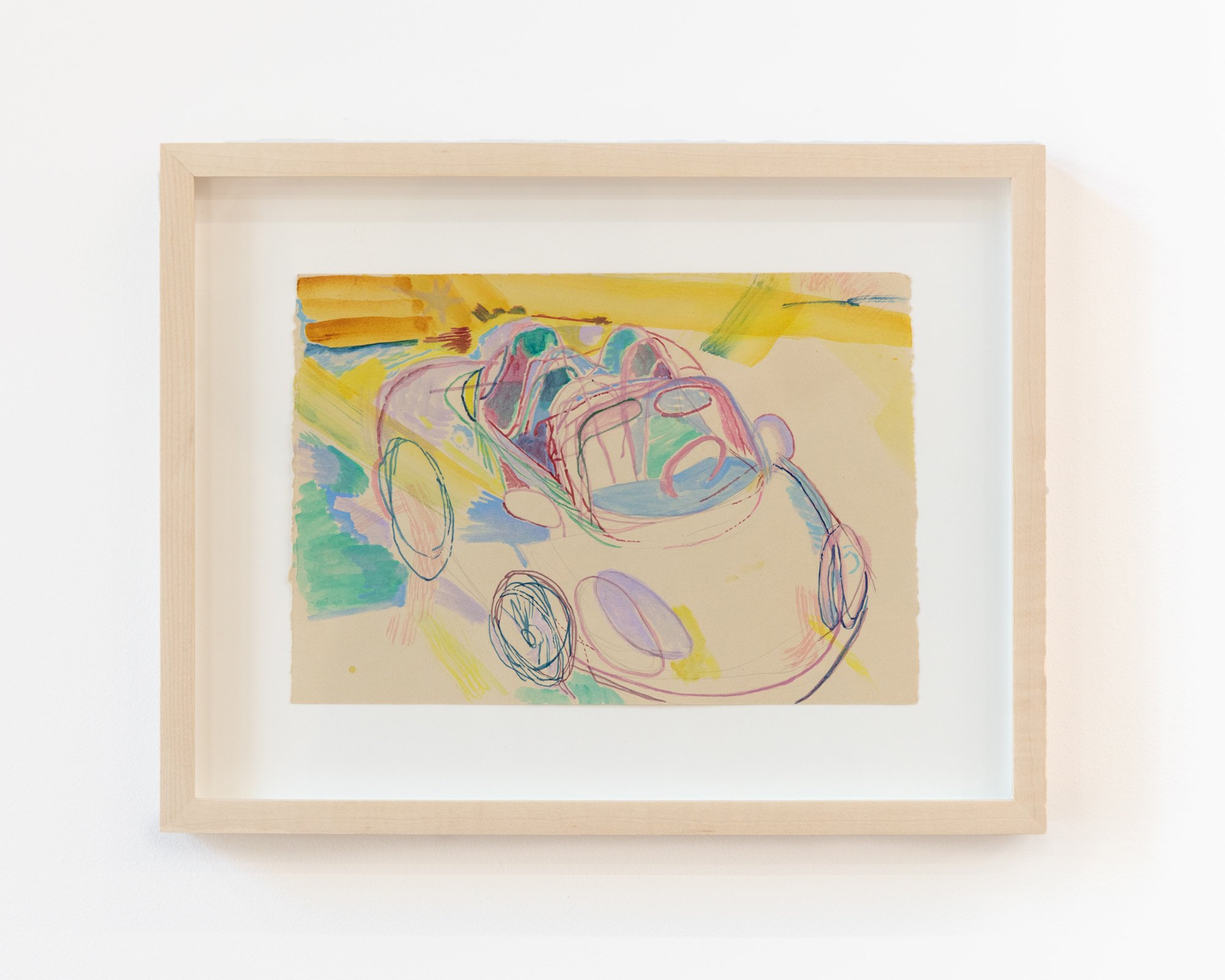Jamie Chan | Dunes.fyi
JAMIE CHAN
Lettuce Makes You Tired
DUNES.FYIseptember 30 - December 18, 2022Introduction
Dunes.fyi is pleased to announce Lettuce Makes You Tired, a solo show by Jamie Chan, an Asian American artist based in Brooklyn, NY. This exhibition weaves together two lives of the artist: that of a full-time office employee, and that of the full-time artist. More often than not the day jobs, which keep one's practice alive are shrouded from the viewer, a holdover perpetuating the myth of artistic practice. In Chan’s case, the openness of this balance informs the work.
“With little time to paint, I had to become more practical in how the paint was applied and decisions were made, breaking down steps and layers in advance and knowing what was achievable in a 2-hour window. Most of the 2 hours would be spent looking, then I would strategize a few marks in order to spiritually move on with my life. I would wake up and brush my teeth near the painting before work. Later, digesting my dinner and listening to music, I would look and paint. Naturally, this shift of day to night energy would become fused into the paintings, making them into accumulations of small transitions and about this version of time” -Jamie Chan
This is the third exhibition at Dunes.fyi in Portland Maine. The show consists of ten paintings, 2 framed drawings, and 4 handmade artists books. The work is varied and colorful, many different pinks punctuating figures in motion. The work is loosely framed around the concept of one’s art practice vs day job, and the effort and optimization required to balance one’s time and energy. Accompanying the show is a tshirt edition of 50, featuring Jamie’s drawing of a baby playing a drum and the text “I feel weird.”
Dunes.fyi Climate Policy
Founded in 2022, Dunes.fyi is a gallery and gathering space that presents exhibitions, book launches, screenings, performances, and talks. As an artist-run space, it continues the tradition of friends caring for friends and critically supporting the art they create.
From the beginning, the gallery’s programming has interrogated our involvement in the natural world. The inaugural show entitled J.O.T.H (Just Over the Horizon), by Miles Huston- and produced in partnership with Gordon Robichaux gallery- asked questions about capital’s compatibility with fighting climate change, the politics of agriculture, and the aesthetics of public spaces. A New York Times review of the show’s iteration at Gordon Robichaux can be seen here, and touches on some of these topics.
Being so new and operationally modest, the climate policy of dunes.fyi evolving. On a macro level, the gallery is committed to advocacy and organizational efforts in securing drastic policy shifts far beyond the inflation Reduction Act (f.k.a. Build Back Better). The IPCC (Intergovernmental Panel on Climate Change) consensus is that the fossil fuel industry needs to end on an emergency timescale. Instead, we hear that we will ‘commit’ to cut emissions by less than 40% by 2030. These kinds of timescales let politicians and corporations off the hook. We need near-term goals that show year by year progressions as to how our emissions will be lowered. This means naming names, and stopping protections for fossil fuel companies. Rather than committing to dismantling the industry, we witness the expansion and protection of it. The IRA bakes into it an increased rate of leasing and drilling on public lands, it expands highways in lieu of transit infrastructure, it converts less than 3% of school buses to electric, etc.
In addition to exhibitions mentioned above, dunes.fyi will host talks with writers, academics, and artists which discuss state planning, collective action, organized labor, the debate around degrowth- and various propositions more radical than what is currently on the table. The gallery will also commit to calculating emissions following this report.
Jamie Chan Statement
This show came together quickly over a 3 month period, as the gallerist and I were friends and already acquainted with each others’ work and general outlook. 6 out of 10 new paintings and drawings were created in the 3 month period. Note: ironically I did quit my job which allowed me the focus and time to make this show. I had already been working towards leaving my job of 7 years, and although I could not really afford to leave, I felt stunted, in need of growth and risk-taking. I would not have been able to make the new works I did had I not quit!
The new works created for this show were made with a staining technique which uses very little quantity of paint, as it is dispersed with water, dried, and layered over many times. In this way, the work enforces the taking of breaks, and in my process I make use of breaks often to spend time looking, questioning, and cultivating patience for what will emerge. My process is more of a slow accumulation rather than project-by-project, so I try to buy materials as needed and make them last. Four of the paintings shown were created between 2016-2018. Only one is painted with oil and the rest are many layers of acrylic, watercolor and ink.
Luckily having a home studio means that I do not have to commute, and that I thoroughly put my space to work, both as a means for artmaking and living, and I hope that this economy of time and resources can become a part of my work’s content. One consideration for having a home studio is how to deal with wastewater and paint rags. I have normally discarded water from washing brushes into the bathroom sink. In completing this report I have started to implement a brush-cleaning system as described by my colleague Roger Carmona, in which buckets of pigment are separated from dirty water and allowed to evaporate, so the hard pigment can then be thrown out instead of going into the water system. I will keep this in mind as I move forward working with both oil and acrylic paint, and other material experimentation.
For oil painting – Roger recommends also using microfiber cloths for cleaning brushes and disposing of turpentine and solvents by pouring it into cat litter. As he says, “According to the EPA, you can dump up to 2 gallons of toxic waste into vermiculite or cat litter before you have to take this toxic waste to a toxic disposal site. I keep a 5-gallon metal bucket of cat litter and dump water and other liquid waste into it in order to never pour anything down the drain.” I think that the cruder, hands-on dealing with materials in this way (although still creating waste) will create greater consciousness around material usage in art, and lead to both innovation and acting better in our world.
Show’s production
Overall, we chose vendors who are local and engage in sustainable practice. For the 2 drawings that needed frames, we chose CityFrame because they are known for affordable, quality work, while using sustainable maple sourced in the USA. They are very waste conscious in their studio practices and donate unused materials to schools, according to Corrine Takasaki.
For shipping, there is only one art shipper that goes between NYC and Portland called Whitney Art Works, and they were able to fit us into their schedule alongside another shipment. 7 paintings were driven from NYC to Portland Maine by Sprinter Van. The artist drove up one painting and the framed works separately. In preparing for shipment, the paintings were packed with simple cardboard collars and plastic sheeting wrap, using cardboard strips and plastic that the artist had stored for many years and will use again after this show. The only new material used for packing that cannot be reused, is shipping tape.
There are 4 handmade books (2015-2019), created from ephemera that I have accumulated over the years, including scratch paper from my office printer, odd flyers, and press releases from visiting art galleries over the years. Therefore no new materials were acquired - I used the linen, paper, acrylic paint and watercolor already at home in my studio. Most of my stretcher bars have been found, gifted from other artists, and reused up until this point.
The editioned t-shirt “I feel weird”:
There were 50 t-shirts produced on the occasion of this exhibition. There was a long trial-and-error process to create the shirt, so there were five drafts created by two t-shirt companies. We chose to work with Everybody.world - a clothing company that specializes in using existing closed loop waste streams for recycled textile production, and the printing was done locally with a Direct-to-Garment printer.
t-shirt available here
Details From Everybody.world – One Tubular Trash Tee
Carbon Footprint | .02 pounds Manufacturing Water Footprint | 2 gallons
Hyperlocal supply chain: A majority of our production happens within a 25 mile loop
100% waste cotton. 100% biodegradable.
No synthetic fibers. No microplastics. No virgin raw materials used
726 gallons of water saved dirt to t-shirt compared to industry standard
Fair wage, supporting small business and local economy: Made in independent and family-owned factories across Los Angeles where workers are treated well and earn fair wages (at least $17/hour)
Each Trash Tee diverts over .5 lb of waste from the landfill, with additional 80% cutting waste reduction by shifting our manufacturing to tubular knits in 2022
Carbon Emissions: 0.274 tCO2e
Travel: 0.09 tCO2e
Jamie traveled to Portland from Brooklyn twice by car.
One was a 2022 Corolla and one was a 2009 Civic.
Distance: 317 miles (x 4)
Gas roughly $50 per round trip
Emergy: 0.11 tCO2e
Central Maine Power meter reading: on 11/15/2022, for 29 days, 104 KWH: 0.04 tCO23
Gas reading: 1 month is about 12 therms: 0.06 tCO23
Shipping: 0.074 CO2e
Work was shipped by Peter and Deb of Whitney Art Works.
Driven by Sprinter van from Midwood, Brooklyn NY to Portland, ME. and back- 2 trips.
7 paintings - exactly 45 LB
Distance: 317 miles one way.
Waste Report
Reuse:
to be reused for the same purpose as the original use
Cardboard
Plastic sheeting
Foam
Bubble wrap
Repurpose:
To be kept, sold, or donated and used for a different purpose in the future
Book display table
Storage:
items sent to storage, but without a clear plan for immediate reuse or repurpose
Artworks (paintings, drawings, books)
Landfill
items sent to a landfill
Some cardboard and plastic sheeting
Packing tape
Collective Action
Have a transparent conversation within the project team about ways that the project can support collective action within the art sector:
Share a climate case study at artistscommit.com. ✓
Use this case study as a framework or model available to other artist projects hosted by the presenting partner. ✓
Share what was learned in the case study to audiences. ✓
Ask project partners and collaborators about their climate policies, commitments, or priorities. ✓
Use this report to develop future reports at Dunes.fyi ✓
Exhibition Info and Credits
CIR Prepared by Jamie Chan, Boru O'Brien O'Connell, Deville Cohen (Artists Commit)
Dunes.fyi
251 CONGRESS ST,
PORTLAND, ME 04101
Exhibition link: https://dunes.fyi/jamiechan/





